
Beneath the beams, abutments, and concrete, Toledo s Maumee crossings have a story to tell
6/17/2007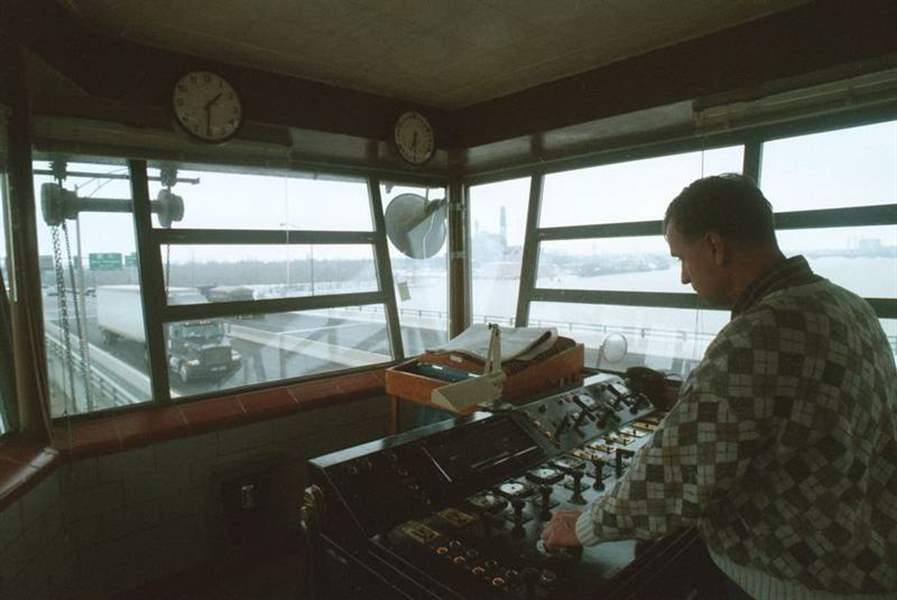
Mike Leasor was at the controls at the Craig bridge in January, 1998. After the bridge was opened to traffic, it became an immediate irritant to motorists who wondered why a drawbridge was placed on an expressway.
More than 20 years ago, regional transportation planners predicted that all four Maumee River bridges would be unable to handle projected traffic loads by 2010.
They said motorists trying to use the bridges might face lengthy delays, traffic backups, and an average speed of only 30 mph even on the two expressway bridges.
And while bridge conditions aren t exactly what they forecast, planners were somewhat on target citing the need for a fifth Maumee crossing.
Dale Rupert, senior professional engineer with the city division of streets, bridges, and harbor, said the new six-lane Veterans Glass City Skyway scheduled to open June 24 is expected to spread out the traffic flow across the river. Some traffic that now uses the Martin Luther King, Jr., Bridge or the DiSalle Bridge the latter carrying I-75 over the Maumee is expected to shift to the new span once it opens.
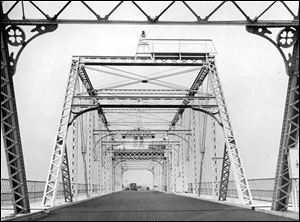
The Fassett Street Bridge, shown in 1938, was badly damaged and later razed after a freighter struck it in 1957.
A 2003 Ohio Department of Transportation traffic study reported that on a typical day, 85,460 vehicles cross the I-75 bridge in Toledo s south end.
Mike Ligibel, the Ohio Department of Transportation s district planning and programs administrator in Bowling Green, said traffic on the I-75 bridge doesn t exceed its peak-hour capacity, but congestion could be lightened as a result of the opening of the additional river crossing.
Mr. Ligibel said part of the bridge s congestion is caused by inadequate merging distance on entrance ramps from Miami Street and South Avenue. The number of vehicles, especially tractor-trailers, entering I-75 from those ramps causes that congestion, he said.
"[The ramps] are short by today s standards," Mr. Ligibel said. "They were fine when they were built, but things change."
The same 2003 ODOT study reported that more than 52,000 vehicles travel the Craig Memorial Bridge daily, which now carries I-280 over the river. Mr. Ligibel said the I-280 and I-75 bridges normally carry similar volumes of traffic.
But construction to build the new river crossing affected the volume of traffic on the I-280 bridge.
Nearly 30,000 vehicles cross the Anthony Wayne Bridge each day, while 26,500 cross the Martin Luther King, Jr., Bridge.

Mike Leasor was at the controls at the Craig bridge in January, 1998. After the bridge was opened to traffic, it became an immediate irritant to motorists who wondered why a drawbridge was placed on an expressway.
Hidden beneath the steel beams, abutments, and miles of concrete, each of Toledo s four major Maumee River crossings has a story.
The first bridge to span the Maumee in Toledo was a wooden structure built in 1865 known then as the Cherry Street Bridge. It stretched 2,200 feet from Water Street at the foot of Cherry on the west side to Front Street in East Toledo.
The structure was originally a toll bridge built by a stock company that charged 2 cents per person, a dime per horse, a nickel a head for cattle, and a penny a head for sheep and hogs.
Just two years after its completion, a flood wiped out one section of the span, heralding an ill fate for the structure, which was swept away by another flood in 1883. A new steel bridge, built in 1884 for about $360,000, lost its western half in a steamship collision in 1908.
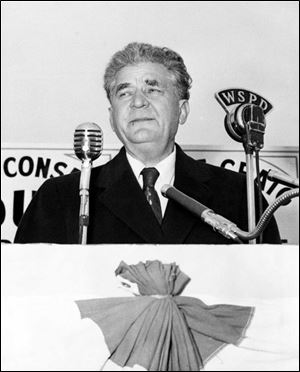
Sen. Frank Lausche was on hand for the 1957 opening of the Craig bridge.
The current concrete-arch bridge from Cherry to Main streets cost $1.2 million and was finished in 1914. It had lift spans, originally powered by two steam engines, instead of a swing span.
Even without the modern technologies of today, Mr. Rupert said bridges built during that era "were, without a doubt, built sturdy."
The bridge, renamed by City Council in honor of Martin Luther King, Jr., was designed to last 50 years, Mr. Rupert said. It has been undergoing renovation since 2002, with half of its drawspans replaced last winter and the other half to be done next winter.
The Fassett Street Bridge was completed in 1896 and was Toledo s second Maumee River crossing. The bridge spanned from Walbridge and South avenues to the east side of the river.
The bridge was badly damaged in 1957 after 80 mph winds ripped a 8,700-ton freighter from its nearby docks sending it crashing into the middle of the bridge. The Fassett Street Bridge was later razed.
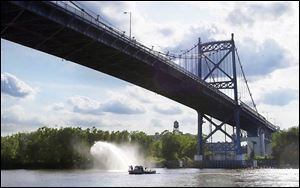
The Anthony Wayne Bridge was opened to traffic in 1931. The 3,215-foot-long suspension bridge has been the site of numerous suicide attempts.
The Anthony Wayne Bridge was built upstream of the former Cherry Street Bridge and opened to traffic in 1931.
The $3 million suspension bridge is 3,215 feet long including approaches and raises 104 feet above the water at its midpoint.
According to The Blade s archives, more than 100 people have either committed suicide by jumping from the bridge or threatened suicide after climbing the bridge s suspension cables.
Toledo Police officer Pam Kujawa, who is a trained negotiator, isn t sure what attracts people to climb that particular bridge.
"There is some draw to that bridge," she said, adding she s never witnessed anyone actually jump from the Anthony Wayne Bridge in her 10 years as a negotiator.
Acting Fire Chief Mike Wolever said police and fire units respond to more jumper calls from the Anthony Wayne Bridge than all the others combined.
"Their chances of survival are less if you jump from that great height," Chief Wolever said.
In 1996, The Blade reported that between one and three people a month tried to jump from the Anthony Wayne, Martin Luther King, Jr., or Craig Memorial bridges.
During that same year, a former city councilman proposed installing barriers to keep would-be climbers off the bridge s suspension cables.
While the barriers were installed in 1997 and have impeded several attempts to climb the cables, "it s not impenetrable," Chief Wolever said.
In 2006, the department received 19 jumper calls, and Chief Wolever said 95 percent of those were probably from the Anthony Wayne Bridge.
"The truth of the matter is, those that climb don t jump," he said.
Officer Kujawa agreed.
"If you re going to commit suicide, you don t let anybody know," she said. "If you do let them know, it s a cry for help. They re looking for somebody to help them and say, This isn t what you need to do. "
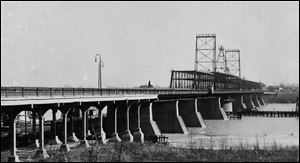
The Ash-Consaul Bridge, which linked North and East Toledo, was replaced by the Craig Memorial Bridge in the late 1950s.
After the Cherry Street Bridge was destroyed in the flood of 1883, city officials towed remnants of the bridge downstream, added two more spans, and created the Ash-Consaul Bridge. The Ash-Consaul Bridge was demolished in 1957 to make way for the Craig Memorial Bridge.
After the Craig Bridge was opened to traffic, it became an immediate irritant to motorists, many wondering why a drawbridge was placed on an expressway.
Mr. Rupert said despite what many think, the drawbridge was designed before the Interstate System was created.
"The interstate was put across a drawbridge," he said. "The drawbridge was not built on the Interstate System."
In 1996, The Blade reported the bridge opened on average 900 times a year for ship traffic, with delays usually lasting a little more than seven minutes.
"It was perfectly appropriate for it to be a drawbridge at that time," said Andrea Voogd, an ODOT spokesman.
Ship traffic has decreased drastically since then with only 266 drawbridge openings last year, according to the Toledo-Lucas County Port Authority.
Despite the reduced number of ship openings, the Craig became a tightening chokepoint on the Toledo freeway system over the years as traffic volumes grew and truck weights increased. Inadequate acceleration room forced the mid-1990s closing of a bridge entrance from northbound Summit Street that was a particular cause of congestion and was blamed for at least one fatal accident. Occasional breakdowns forced I-280 traffic to detour along city streets.
When it becomes part of State Rt. 65 next weekend, the Craig bridge will lose its status as one of a handful of drawbridges remaining along the Interstate System. Others are in New York City; Newark, N.J.; Norfolk, Va.; Washington, and across the Columbia River near Portland, Ore.
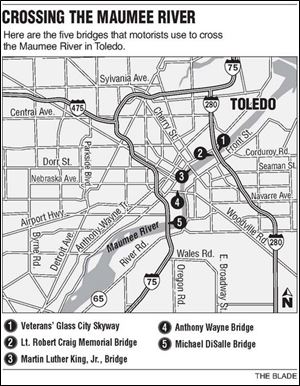
The I-75 bridge named for Michael DiSalle, a former Toledo mayor and Ohio governor, opened on Nov. 22, 1963 the day President John F. Kennedy was assassinated.
At the time of its construction, it was the longest at 3,401 feet and most expensive Maumee River crossing. It was 203 feet longer than the Anthony Wayne Bridge and cost $13.4 million to construct.
The Veterans Glass City Skyway project cost an estimated $220 million and is 8,800 feet long including approaches, shattering the DiSalle s past claim to fame.
Almost a decade after opening the I-75 span, state highway crews posted signs identifying it by name. A sign was also suspended from the I-280 bridge officially proclaiming it as the Robert Craig Memorial Bridge.
The Federal Highway Administration said those signs violated regulations that forbid designating parts of the Interstate System as memorials. The signs were removed a year after they were put up under threat of a cutoff of federal highway funds.
Current law states there are no limitations on designating interstate bridges as memorials, according to Doug Hecox, spokesman for the Federal Highway Administration.
Contact Laren Weber at:
lweber@theblade.com